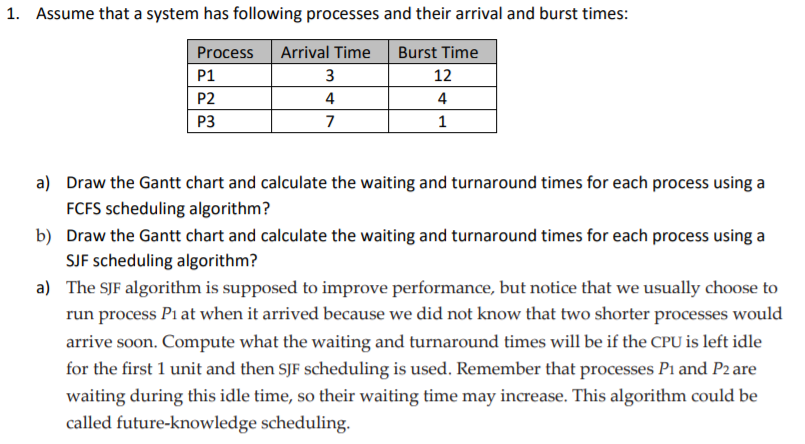Question
1 a. Draw the Gantt chart and calculate the waiting and turnaround times for each process using a FCFS scheduling algorithm. b. Draw the Gantt

1 a. Draw the Gantt chart and calculate the waiting and turnaround times for each process using a FCFS scheduling algorithm.
b. Draw the Gantt chart and calculate the waiting and turnaround times for each process using a SJD scheduling algorithm.
c. The SIF algorithm is supposed to improve performance, but notice that we usually choose to run process P1 at when it arrived because we did not know that two shorter processes would arrive soon. Computer what the waiting and turnaround times will be if the CPU left is left idle for the first 1 unit and then SJF scheduling is used. Remember that processes P1 and P2 are waiting during this idle time, so their waiting time may increase. This algorithm could be called future-knowledge scheduling.
1. Assume that a system has following processes and their arrival and burst times: Process Arrival Time Burst Time P1 P2 P3 12 4 4 7 a) b) a) Draw the Gantt chart and calculate the waiting and turnaround times for each process using a FCFS scheduling algorithm? Draw the Gantt chart and calculate the waiting and turnaround times for each process using a SJF scheduling algorithm? The SIF algorithm is supposed to improve performance, but notice that we usually choose to arrive soon. Compute what the waiting and turnaround times will be if the CPU is left idle for the first 1 unit and then SJF scheduling is used. Remember that processes Pi and P2 are waiting during this idle time, so their waiting time may increase. This algorithm could be alled future-knowledge schedulingStep by Step Solution
There are 3 Steps involved in it
Step: 1

Get Instant Access to Expert-Tailored Solutions
See step-by-step solutions with expert insights and AI powered tools for academic success
Step: 2

Step: 3

Ace Your Homework with AI
Get the answers you need in no time with our AI-driven, step-by-step assistance
Get Started


